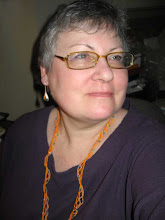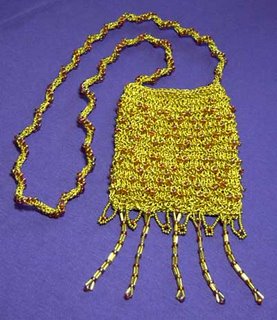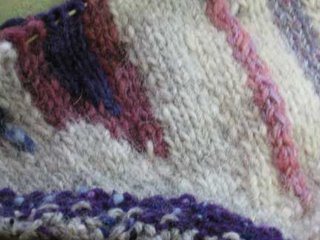Donna Druchunas, author of
Arctic Lace, has graciously agreed to be interviewed here about her research for this fascinating new book. Like all of my very favorite knitting books, this one is not just about knitting.
cfm: I'm sure that others will be asking you all about the animals, the fiber, and the stitches. What I'd really like to know more about is the The Yup’ik and Inupiat people from an anthropological standpoint. What got you interested in this particular part of the world?
DD: I read an article about the Oomingmak Musk Ox Producers’ Co-operative in Piecework magazine a few years ago (Berlo, Janet Cahterine, “Oomingmak: Knitting Vision into Reality,” Piecework, Jan/Feb 1996, page 50). After I read that, I became obsessed with finding out everything I could about the women in this organization, the founders, the knitting techniques used, and the musk ox. Of course, I also fell in love with qiviut (kiv’-ee-yoot) yarn.
cfm: Have you learned any of the native languages?
DD: I’ve only learned a few Eskimo words during my research for Arctic Lace. Until you asked this question, I’d never seriously considered learning one of the Native languages. But now I’m thinking, “Maybe I could learn Yup’ik!” I’ve always wanted to speak at least five languages. I know English, some Spanish and German, and will be studying a bit of Lithuanian for a trip next year. Maybe Yup’ik can be my fifth language. Thanks for putting that seed in my mind!
Here are a few interesting words:
Qiviut means “down”. The original Inupiat word meant either the feather down from a bird or the fur undercoat of a mammal. There is no standard English spelling. Some variations I’ve seen include qiviuk qiveuk, and qiviuq. The “qiviut” spelling is trademarked by the Oomingmak Co-op in Alaska. Today that spelling is generally used to refer to musk ox down, while other spellings are still used to refer to feather down or fur down, depending on the context.
Oomingmak means “the bearded one” and is the Inupiat name for the musk ox. A very fitting and descriptive name, since the outer guard hairs of the musk ox continue to grow throughout the animal’s life and can reach up to two feet in length.
Igloo or iglu means “house”. In Alaska, the traditional dwellings of both Yup’ik and Inupiat people were sod homes. In the south western river delta’s of Alaska, the Yup’ik people used driftwood to build the frames of their winter houses. In the north, the Inupiat people used whale ribs. In the summer, most of the people in both areas traveled to fish camps and lived in various types of tents and temporary dwellings.
Akutuq is Eskimo ice cream. It is made from rendered fat, meat (usually salmon or other fish), and berries. I was very disappointed that I didn’t get to try this or any other Eskimo dishes when I was in Alaska. Even in Unalakleet, where I stayed in a lodge, the meals served were hamburgers and other American “delicacies”. Not! I did get to have a lot of great seafood during my travels, however. I’d like to go back to Alaska in the summer and catch and dry some wild salmon, and pick wild berries to make jam. I’d also like to have a chance to try some authentic Eskimo dishes.
For those who want to learn more, there is an Inupiat dictionary online here: http://www.alaskool.org/LANGUAGE/dictionaries/inupiaq/default.htm
I have not found an online Yup’ik dictionary, but I was able to borrow the Yup’ik Eskimo Dictionary by Steven A. Jacobson on interlibrary loan.
cfm: Aboriginal peoples everywhere tend to name themselves “The People,” as if they were the only ones. The word Inuit means “people.” Yup’ik-speaking peoples call themselves “Yup’ik,” meaning “real person.” Is there a similar meaning to “Inupiat”?
DD: Yes, Inupiat does have the same meaning. I think it is very interesting that so many Native American groups called themselves “the people” or “the real people”. I assume that shows how the Native peoples across the Americas are related, and yet at the same time by calling themselves the real people, each group excluded the others as outsiders.
By the way, before I went to Alaska, I thought it was rude to use the word “Eskimo”, but while I was there I discovered that this term is used by the Native people to describe themselves. There are several distinct groups of Eskimos in Alaska including Yup’ik, Cup’ik, St. Lawrence Island Yup’ik, and Inupiat, so having an umbrella term to include all of these groups is helpful. It also helps to differentiate these peoples from the Indian groups that live in other parts of Alaska.
cfm: Aside from the knitting co-operative, were you able to look into other native arts and crafts? Which are still practiced by native artisans?
DD: Yes, I’ve been writing a series of articles for Piecework magazine called “Needleworkers of the North.” For the first article, I did a lot of research into the skin and fur sewing that is done by Eskimo men and women across Alaska. The second article was about Athabascan beadwork, and the third covered Tlingit and Haida button blankets. I’m currently working on a fourth article about quillwork, and I don’t think I’ve begun to scratch the surface.
cfm: Do you see any similarities between the Oomingmak Musk Ox Producers’ Co-operative and Emma Jacobsson’s Bohus knitters?
DD: The main similarity between the Oomingmak knitters and the Bohus knitters is that of economic imperative. This is something we talked about quite a bit at the Boise Lace Knitting Retreat I attended earlier this month. I gave a presentation about the Oomingmak co-op and Myrnah Stahman gave a presentation about Shetland lace knitters. Both groups developed lace knitting patterns that were primarily meant to be sold. The knitters on the Aran Islands in the early 20th century had similar goals, and even some Shaker knitters in the United States made rugs and other home decor items to sell to the general public. All of these groups were founded to generate income for people in rural communities.
They also all created unique styles of knitting that began as local products and ended up being instantly recognizable around the world. In addition, the products that are created use techniques and styles that are generally designed for speed of knitting and easy sizing. Aran sweaters, for example, were originally made in the circular fashion using fine, dark blue yarn. Later the heavy weight, natural colored yarn was used to make raglan and drop shoulder sweaters that were knitted flat in pieces and sewn together. These sweaters could be made more quickly and patterns for multiple sizes were easier to write for flat knitting. In the Oomingmak co-op, the left leaning decrease used is knit two together through the back loops. This is by far the fastest left leaning decrease to knit. Although it is not quite as tidy looking as slip slip knit or slip 1, knit 1, psso, the difference is negligible when knitted in lace-weight qiviut yarn (the stitches are quite small, and the bloom helps disguise the twisted stitches). I’m sure the Bohus knitters had their own tricks for making commercial products quickly.
cfm: You have said (and I paraphrase) that spirituality arises naturally out of human consciousness. Clearly you have given this a great deal of thought. What can you tell us about the spirituality of the people you encountered in Alaska? Do elements of the traditional beliefs remain, albeit in a Christianized context?
DD: Christian missionaries tried to squash the Native culture in Alaska during the early 20th century just as they did in the lower 48 during the 19th. They were somewhat successful in prohibiting Native dances and many ceremonies and rituals at first, but today the people are starting to practice some of their traditions again. Fortunately in many areas there are still Elders who remember many of the rituals and celebrations that were forbidden by the missionaries. As with other Native American groups, traditional Yup’ik and Inupiat spirituality focuses on the unity of man and nature.
I really cannot understand why Native Alaskan person would adopt the religion of the Europeans. These strangers came and gave absolutely no respect to the cultures that they found, beat children who spoke Eskimo in school, destroyed beautiful dance masks, and did everything they could to make the “savages” conform to their view of “civilization”. (I am not a cultural relativist, but I don’t think the Europeans and Americans of the 19th century, or the earlier explorers, exhibited behavior that qualifies as “civilized.”)
I read one essay by an Inupiat woman who explained that her grandparents had been very happy to adopt the white man’s religion, because before they heard of Christianity they were afraid of many of the spirits they thought surrounded them. Christianity alleviated this fear and they raised their children and grandchildren in the Christian faith. Today it seems like the majority of Eskimos are devout Christians.
Personally, I find it sad that these people gave up their beautiful traditions in exchange for a new set of superstitions. Wouldn’t it have been better for them to keep their own cultural treasures as traditions, even if they abandoned the belief in spirits that was frightening them?
cfm: What is the question you most wish I would ask?
DD: That’s a hard one. There are so many topics to talk about! In fact, the book as it stands today includes less than half of what I had originally written. I’m sure my editor had a heart attack when she read through the manuscript I originally turned in. But she was very diplomatic and helpful in pointing out the portions she thought were most appropriate for a knitting book and helping me revise each chapter to make it more friendly. I’m quite sure my original version would have been completely overwhelming to the average reader. The part I was saddest about deleting was a section describing some of the traditional Yup’ik and Inupiat ceremonies.
I learned so much during my research, I’m sure I could continue writing about these topics for the rest of my life, but other book ideas are also chomping at my heels.
cfm: Optional question: Most of what I think I know about contemporary Alaska comes from the TV show, “Northern Exposure.” If you are familiar with that show, could you point out some ways in which the reality differs from the fiction?
DD: Sorry, but I’ve never seen Northern Exposure. I do have one interesting entertainment note, however. The 2002 movie, Insomnia, starring Robin Williams supposedly took place in Nightmute, Alaska. Several knitters from the Oomingmak Co-op live in Nightmute. The village’s population is over 90% Native, and yet in the movie, the town is predominantly white. I guess they just thought the name “Nightmute” sounded good, but they didn’t care to use the real village in the film. So much for authenticity!
cfm: Thank you so much for your insights and time.
DD: Thank you for asking such interesting and thought provoking questions!
Donna










